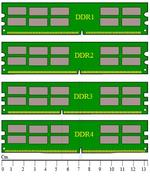
Difference between DDR1 DDR2 DDR3 DDR4
Compare DDR1 vs DDR2 vs DDR3 vs DDR4 and explore difference between DDR1 DDR2 DDR3 DDR4 SDRAM memory types.
Showing 9 posts (Page 1 of 1)
Advertisement

Compare DDR1 vs DDR2 vs DDR3 vs DDR4 and explore difference between DDR1 DDR2 DDR3 DDR4 SDRAM memory types.

Explore 5 key pros and cons of DRAM (Dynamic Random Access Memory) in computer systems, including its volatility, speed, cost-effectiveness, and limitations.

Explore the benefits and drawbacks of LPDDR5 RAM, a low-power memory standard used in mobile devices, focusing on speed, power consumption, and performance.

Explore the basics of Radar Absorbing Material (RAM) and Paint, including types, vendors, and applications for reducing radar reflections.

Explore Verilog code implementations for RAM (Random Access Memory) and ROM (Read Only Memory) with detailed examples and figures.

Explore the distinctions between RAM and cache memory, focusing on speed, capacity, cost, and application in computer systems.
Understand the key differences between RAM and ROM, and explore the characteristics of Static RAM (SRAM) and Dynamic RAM (DRAM).
VHDL code example for reading from and writing to a Random Access Memory (RAM), with detailed explanations of the code structure and functionality.

Explore the differences between SRAM and DRAM memory, including speed, volatility, density, and power consumption. Understand which type is best for different applications.
Advertisement